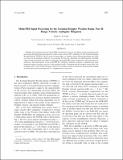Multi-PRI Signal Processing for the Terminal Doppler Weather Radar. Part II: Range–Velocity Ambiguity Mitigation
Author(s)
Cho, John Y. N.
DownloadJTECH1805.pdf (1.253Mb)
PUBLISHER_POLICY
Publisher Policy
Article is made available in accordance with the publisher's policy and may be subject to US copyright law. Please refer to the publisher's site for terms of use.
Terms of use
Metadata
Show full item recordAbstract
Multiple pulse-repetition interval (multi-PRI) transmission is part of an adaptive signal transmission and processing algorithm being developed to combat range–velocity (RV) ambiguity for the Terminal Doppler Weather Radar (TDWR). In Part I of this two-part paper, an adaptive clutter filtering procedure that yields low biases in the moments estimates was presented. In this part, algorithms for simultaneously providing range-overlay protection and velocity dealiasing using multi-PRI signal transmission and processing are presented. The effectiveness of the multi-PRI RV ambiguity mitigation scheme is demonstrated using simulated and real weather radar data, with excellent results. Combined with the adaptive clutter filter, this technique will be used within the larger context of an adaptive signal transmission and processing scheme in which phase-code processing will be a complementary alternative.
Date issued
2005-10Department
Lincoln Laboratory; Massachusetts Institute of Technology. Department of Earth, Atmospheric, and Planetary SciencesJournal
Journal of Atmospheric and Oceanic Technology
Publisher
American Meteorological Society
Citation
Cho, John Y. N. “Multi-PRI Signal Processing for the Terminal Doppler Weather Radar. Part II: Range–Velocity Ambiguity Mitigation.” Journal of Atmospheric and Oceanic Technology 22, 10 (October 2005): 1507–1519 © 2005 American Meteorological Society
Version: Final published version
ISSN
0739-0572
1520-0426